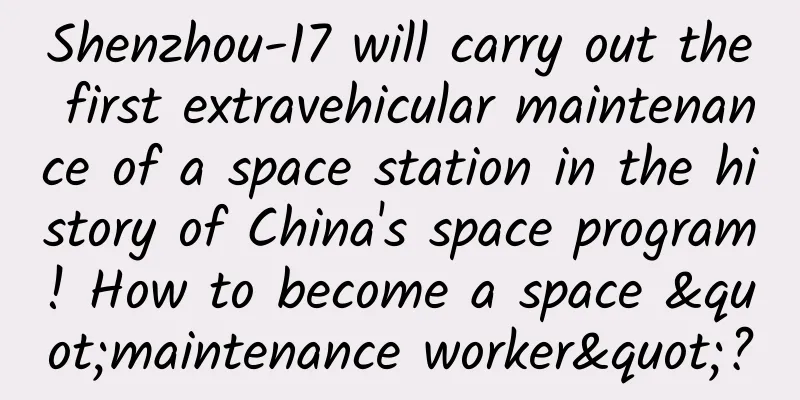Shenzhou-17 will carry out the first extravehicular maintenance of a space station in the history of China's space program! How to become a space "maintenance worker"?

|
On October 26, the Shenzhou 17 manned spacecraft transported three astronauts to the Tiangong Space Station. In addition to carrying out routine work such as taking care of the space station complex platform, conducting on-orbit experiments, and carrying out popular science and public welfare activities, they will also go out of the cabin to repair the slight damage to the solar panels of the space station caused by the impact of tiny particles in space, completing the first extravehicular maintenance operation of the space station in the history of China's space exploration. So what problems need to be solved in different space maintenance tasks? What new technologies can space researchers hope to use to complete their tasks? Space exploration calls for "maintenance workers" In the process of human exploration of the universe, various unexpected problems often occur. For example, in the space environment, due to the lack of protection from the Earth's atmosphere and magnetic field, the electronic devices of spacecraft may fail unexpectedly under the radiation of cosmic rays. During high-speed flight, the continuous friction between the surface of the spacecraft and the seemingly thin atmosphere will also generate high temperatures, accelerating the aging and damage of the spacecraft's external equipment. In addition, with the continuous development of outer space exploration activities, the space waste left by humans is increasing, including many tiny fragments that are difficult to detect, and it is inevitable that they will hit spacecraft. Astronauts performing space maintenance missions When a spacecraft encounters various accidents and malfunctions, astronauts are required to have strong space maintenance capabilities to ensure the smooth progress of space missions. Space maintenance is an important topic and key link in the field of aerospace, mainly the technology of repairing and maintaining various spacecraft such as satellites, space stations, and space transport vehicles in space. Specifically, the maintenance objects include the external and internal structures of the spacecraft, the support systems necessary for the life and work of astronauts, various electronic equipment and lines, as well as the restoration of the spacecraft's operating status and orbit correction. As part of the space exploration mission, space maintenance is indispensable and directly related to whether the spacecraft can operate stably for a long time and whether the normal mission progress can be guaranteed. For manned spacecraft, the life safety and health of astronauts directly depend on the efficiency and quality of space maintenance. In addition, efficient space maintenance can also extend the service life of spacecraft, reduce the generation of space debris, and contribute to the sustainable use of the space environment. Previously, foreign countries have successfully carried out space maintenance missions many times, including the space shuttle using a robotic arm to recover abandoned satellites, and astronauts personally repairing the Hubble telescope's photosensitive detectors and plugging the leaks in the International Space Station. In the future, humans will explore deeper space, and these valuable near-Earth orbit work experiences are expected to escort deep space missions. Solving problems in different fields Looking at the space missions and future plans of various countries, space maintenance work can be divided into two categories: manned and unmanned, each with its own technical challenges that need to be solved. Currently, on-orbit maintenance by astronauts is the most common way of space maintenance. Astronauts can perform necessary maintenance and repairs on spacecraft through extravehicular activities to ensure flight safety and complete missions. Considering the harsh environment outside the cabin, astronauts must wear special extravehicular spacesuits. These spacesuits weighing tens of kilograms protect astronauts from external radiation and space debris, but also greatly limit astronauts' observation field, activity space and physical strength, increasing the difficulty of space maintenance. In addition, due to the influence of the microgravity environment, the role of forces is more complicated. Many operations that can be easily completed on the ground are more difficult in space. Astronauts need to maintain a relatively stable state of motion and a reliable constraint relationship with the spacecraft. Although special tools such as safety ropes and magnetic gloves can help astronauts adapt to the space environment, they also reduce the efficiency of space maintenance. Despite many successful experiences, space maintenance is still a very challenging task. Simply put, space maintenance work involving astronauts faces at least three obstacles. First of all, the space maintenance environment is almost zero gravity, and maintenance equipment and parts are floating around in space. Astronauts must perform maintenance work while ensuring that many tiny items are under control, so they need more special tools and equipment to complete the task. Secondly, the space maintenance environment is filled with high radiation energy from different directions, which will not only have a negative impact on the reliability and performance of electronic equipment, interfere with astronauts' operating results, and hinder smooth communication with ground personnel, but also pose a threat to astronauts' physical and mental health. Finally, the space maintenance environment is in high-speed motion. If astronauts lose connection with the spacecraft while performing extravehicular operations, it may be difficult for them to return to the spacecraft smoothly. Schematic diagram of a space robot docking with a satellite to provide on-orbit services As artificial intelligence technology continues to advance, aerospace researchers have gradually turned their attention to the field of unmanned space maintenance, hoping to use professional space robots to perform daily maintenance tasks more efficiently and safely, and resolve fault hazards when necessary. However, space robots still face some difficulties in completing on-orbit maintenance tasks. On the one hand, the design of current spacecraft does not provide much for maintenance work, lacks the so-called "reference marks", and has no special grabbing devices reserved for robots. Therefore, it is not easy for space robots to visually locate moving satellites and other spacecraft, and it is even more difficult to effectively grasp and fix them. In other words, space robots are only suitable for specific matching spacecraft in the short term, and their versatility and cost-effectiveness are greatly reduced. On the other hand, the communication delay between the space robot and the control team is still difficult to ignore. For a space robot operating in geosynchronous orbit, the long distance causes at least a few seconds of communication delay between it and the control team, which inevitably requires the robot to be able to handle the most delicate work autonomously and resolve emergencies. Under the current technical level, this undoubtedly reduces the reliability of the space robot and increases the mission risk. Cutting-edge technology provides support With the development of technologies in multiple fields, space maintenance work will also benefit greatly, and mission efficiency, cost-effectiveness and personnel safety are expected to be significantly improved. Automation technology is expected to assist or replace relatively simple and repetitive space maintenance work by using automated tools. For example, the robotic arm can accurately pick up, carry, locate and release different personnel or equipment inside and outside the spacecraft cabin by using the positioning function of each component. In space maintenance, through the technology that combines astronauts' autonomous operation on orbit with remote control operation, the robotic arm can complete large-scale maintenance actions outside the space station or other orbiters, or serve as a support platform for astronauts and large components to assist in completing complex tasks outside the cabin, effectively improving maintenance efficiency, reducing human errors, and reducing hidden dangers. The robotic arm supports astronauts' extravehicular work 3D printing technology can quickly manufacture the required parts and tools in space, providing a new solution for space maintenance work. When key parts of a spacecraft are damaged, space maintenance must be completed in a very short time, but the limited space and high transportation costs of space transportation vehicles have traditionally hindered the efficiency of backup replacement. With the help of 3D printing technology, astronauts can quickly obtain irregularly shaped parts and repair and replace them in a timely manner, greatly reducing waiting time and transportation costs, which is enough to improve mission flexibility and reliability and avoid the potential risk of delays in space maintenance. With the development of space-to-earth communication technology, remote space maintenance similar to telemedicine has gradually become a reality. With the help of real-time communication and monitoring, and with the support of intelligent auxiliary systems, ground professionals can implement remote guidance and remote operation, which will undoubtedly improve the efficiency of space maintenance. For example, in complex electronic equipment maintenance tasks, ground professionals can grasp the details of the fault in real time, explain the working principles of related components, quickly form a maintenance plan, and perform remote operation through automated equipment when necessary to assist astronauts in completing danger elimination and maintenance tasks, thereby significantly reducing the workload of astronauts and reducing the intensity of astronaut training and knowledge reserve costs. Land simulation technology can help astronauts conduct a series of space mission training on the ground, improve their space operation skills, and become familiar with space work processes by building a space-like scene and providing support conditions suitable for the space operation environment. For example, in land simulation maintenance, astronauts will conduct maintenance operation verifications at multiple levels in a neutral buoyancy tank, simulate the handling of problems that may be encountered in space maintenance, and conduct team communication and coordination adaptability training, which will undoubtedly improve the reliability and safety of space maintenance missions. In short, space maintenance provides a safe and reliable guarantee for spacecraft. From rescuing satellites to repairing space stations, humans have made brave attempts in the field of space maintenance and have achieved remarkable results. I believe that with the continuous advancement of science and technology, space maintenance will develop in a more efficient, safe and automated direction in the future. The vast number of aerospace researchers will promote the advancement and application of space maintenance technology and provide a more solid guarantee for human exploration of the universe. (Author: Li Ruopeng Some pictures from: NASA Checkpoint Expert: Jiang Fan, Deputy Director of the Science and Technology Committee of China Aerospace Science and Technology Corporation) |
<<: Guangzhou residents saw dolphins in the Pearl River! How did the dolphins get into the river?
>>: The color of your quilt really affects your sleep quality! Change it now!
Recommend
5.81 million people participated in Tencent’s “Children’s Gallery” charity event. From being popular to being questioned, why was it so popular?
On the morning of August 29, the WeChat Moments w...
China Automobile Dealers Association: China Automobile Retention Value Report in May 2020
On June 1, 2020, the China Automobile Dealers Ass...
Little Red Book Promotion Notes Marketing Strategy!
If you ask me which platform users enjoy watching...
Why can I finish two bowls of rice after swimming, but have no appetite after running?
Review expert: Shen Yingjian, Director of the Nut...
Wolves and moose entered the same isolated island: 69 years later, the wolves were extinct!
Many people may be curious about what would happe...
iPhone 6 won’t be sold in China: Apple, please tell me something
Apple's iPhone 6 has passed a key regulatory ...
New WeChat feature: Teach you a trick to quickly find out who deleted you without disturbing any friends
[[412868]] 01 Check the other person’s circle of ...
Subverting the law of "cannot live without water"! The fourth generation of nuclear power is expected in the future!
Human development is inseparable from energy, and...
High repurchase fan community operation strategy
Among the three major categories of communities, ...
Mayu product operation analysis!
Menstruation is a very private and important matt...
An ideal city on the shore of Lingdingyang, 50 pictures tell a story of Zhuhai
Today is the anniversary of Macau's return to...
The key words in my design: matching
In the mobile era, users' aesthetic requireme...
Why are there such big differences in the prices for WeChat mini program development and mini program development?
It has been 6 years since the mini program was la...
The trend of "Four Uncles" playing with skewers has spread to children! Will primary school students get tenosynovitis from playing with skewers?
When it comes to playing with bracelets, the firs...









